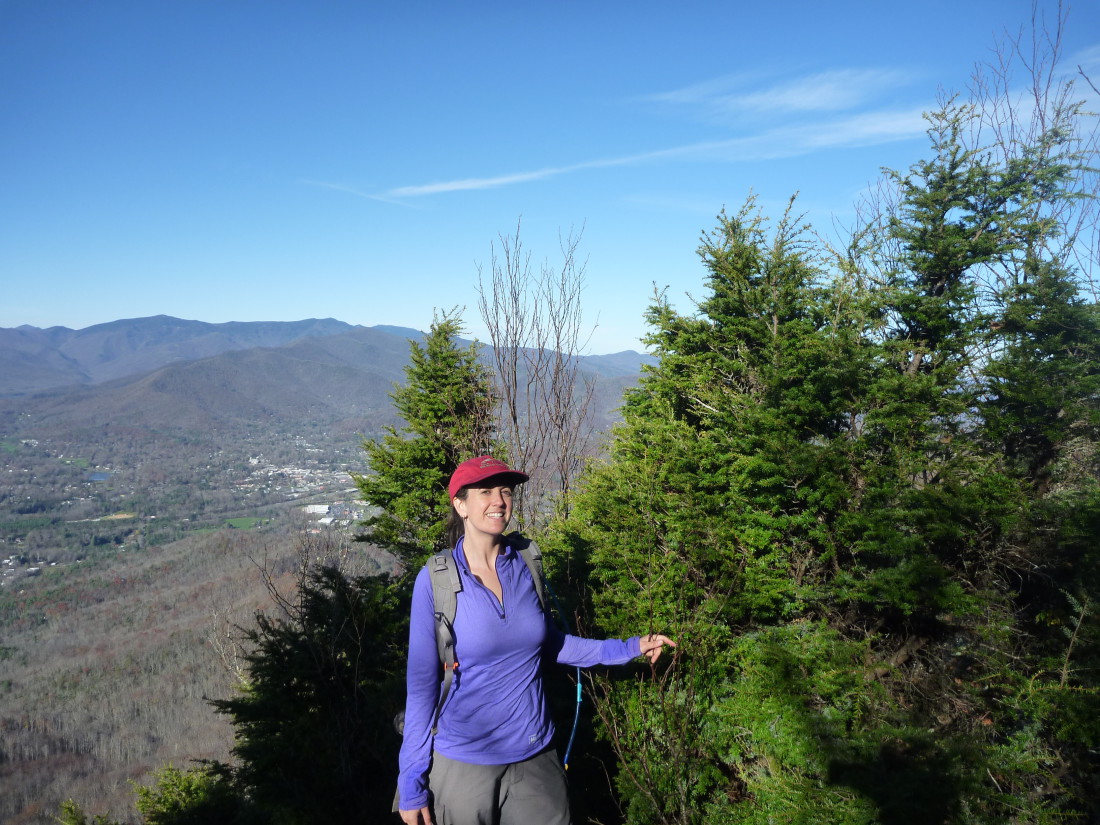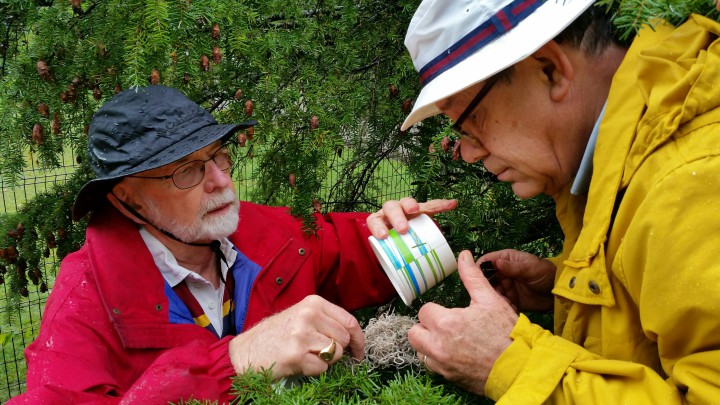Since its accidental arrival here from southern Japan about two decades ago, the hemlock woolly adelgid has killed hundreds of thousands of trees, devastating some forests in the region. Exact numbers are hard to come by, says Margot Wallston, statewide coordinator for the Hemlock Restoration Initative, but hemlocks “are a major player in our forested and residential landscapes. Many local natural-resource managers estimate the loss to be upward of 80 percent, especially in areas with naturally high hemlock densities.” The initiative is a program of WNC Communities, an Asheville-based nonprofit.
Public lands aren’t the only areas at risk, however: The invasive insect can also infect homeowners’ trees, requiring costly removal, notes Bill Yarborough, special assistant to state Agriculture Commissioner Steve Troxler. His department is helping fund the hemlock initiative, using money from North Carolina’s billion-dollar settlement with the Tennessee Valley Authority. Attorney General Roy Cooper sued the TVA, claiming the agency had failed to meet Clean Air Act standards; in 2011, the U.S. Supreme Court agreed.
Since 2014, North Carolina has funneled $350,000 of the settlement money to the hemlock initiative, seeking to limit the damage to the state’s agriculture, tourism and recreation industries. The U.S. Forest Service is also funding the project.
The mission, says Wallston, “is to work with a variety of partners to restore hemlocks to long-term health throughout North Carolina and ensure that both eastern and Carolina hemlocks can withstand adelgid attacks and survive to maturity on public and private lands.”
The Agriculture Department, says Yarborough, chose WNC Communities because it “has experience in grants management, project development and using partnerships to achieve goals that benefit the region. We felt confident they could bring together the right mix of researchers, funding organizations and others to help the initiative be successful.”
The stakes are high, he notes, partly because of the damage already done. “The sheer number of losses to the insect has left a large amount of dead and decaying organic matter that could have a devastating effect should fire get started in many of our forests.”
A keystone species
More than 120 animal species, says Wallston, depend on the hemlock forests for everything from shade to shelter. “Brook trout and other endangered aquatic species, such as the eastern hellbender, are at a tipping point in the Southern Appalachians,” she explains, “where even slight increases in stream temperature can result in unsuitable habitat” that could spell trouble for fishing enthusiasts.
Chris Ulrey, the Blue Ridge Parkway’s plant ecologist, also underscores the tree’s importance, noting, “The hemlock is considered a keystone species, meaning a lot of other species depend on it.”
The visual impact, says Ulrey, has been significant as well. “We have numerous overlooks with long-range views, and you can see huge stands of dead trees. Ten years ago those trees were gray and in decline; now they’re completely dead.”
The Hemlock Restoration Initiative, says Wallston, is “open to all innovative and promising strategies.” For the most part, though, the project “has been focusing resources on three strategies: chemical control, biological control and genetic research. These can also be thought of as short-term, ongoing and long-term strategies — and ultimately, all work together.”
This integrated approach, says Yarborough, includes “treating trees on conserved and state-owned lands, breeding and releasing beetles that eat hemlock woolly adelgids, co-hosting forums and educational meetings, and informing landowners about how to treat their own trees.” The focus, he continues, is on “bringing together all the knowledge and support at our disposal to solve the problem. It’s a grant program, but it’s also an educational effort and a coordination effort to promote greater interaction among researchers and others who are working on hemlock health.”
A multifaceted attack
Traditionally, chemical and biological approaches have been kept separate, says Bud Mayfield III, research etymologist with the U.S. Forest Service’s Southern Research Station in Asheville. Now, however, researchers are finding that “You can treat some trees with chemicals prior to a [biological] release while leaving other trees untreated, and then go in and release predators. So when the chemical eventually wears off, the predators can move over onto those previously treated trees once the adelgid comes back on them.”
After extensive study in quarantine, a predator beetle that’s native to Japan made its debut here last winter. It will take a few years, though, to determine that strategy’s effectiveness. “There are millions of adelgid, and you may release a few hundred, or a thousand [beetles] at most,” Mayfield explains. “Once they disperse, it’s hard to find them until they start reproducing. Within two to three years, you can begin to tell whether or not it was successful and if the insect established itself.”
Healthy hemlocks, notes Wallston, can often handle up to about a 30 percent infestation before it becomes problematic. “If a tree has a heavier infestation and is exposed to other stressors, such as drought, nutrient depletion, root compaction, etc., then it will likely start to show signs of decline more quickly. It can take several years for a tree to progress from healthy with a light infestation to functionally dead.”
And in any case, stresses Mayfield, there will still be many casualties. “The hard truth is, we’re going to lose a lot of hemlocks as we continue to use the tools we have.” But he takes heart from the strong show of community support, saying, “It’s encouraging to me that there are a lot of people that care deeply about this issue. Everywhere I go, people really love eastern hemlocks.”
Restoring balance
Local government is also contributing. In each of the past two fiscal years, the Buncombe County commissioners have allocated $25,000 for a program called Bringing Beetles to Buncombe. “We’re not going to solve the problem ourself, but I think it’s very important that Buncombe County be a partner in the larger regional effort to preserve our hemlocks, especially on our local public lands,” says Commissioner Brownie Newman.
He likens the loss of the iconic species to the blight that wiped out the American chestnut in the early 1900s. “When people watched the American chestnut die, there was nothing they could do about it. But there are things we can do now, and I feel it’s imperative that we do everything we can.”
Ulrey, though, points out a major difference between chestnut and hemlock. “When the chestnut died, the space left behind was occupied by oaks and maples. We really don’t have another native species that’s the ecological equivalent of the hemlock.”
Recently, however, the initiative has gotten an assist from the weather. “The cold winters of 2013-14 and 2014-15 led to high adelgid mortality, which gave our trees a chance to breathe, literally, and put on new growth without being immediately clobbered by another generation” of pests, says Wallston.
“There’s also a lot of regeneration in our forests that may fare better, due to there currently being less adelgid pressure,” she continues. “Loss of mature hemlocks in the canopy means fewer adelgids to drop down to understory trees.”
Ultimately, Wallston maintains, learning to live with the adelgid while mitigating its effects may be the best we can hope for. “If it can be kept at a low enough level that it doesn’t overwhelm our trees, then we will be successful. It’s about restoring balance.”
But don’t expect to see that happen in your lifetime, cautions Ulrey. “In about 300 to 400 years,” he predicts, “we’ll be back to where we were when all this started.”




Before you comment
The comments section is here to provide a platform for civil dialogue on the issues we face together as a local community. Xpress is committed to offering this platform for all voices, but when the tone of the discussion gets nasty or strays off topic, we believe many people choose not to participate. Xpress editors are determined to moderate comments to ensure a constructive interchange is maintained. All comments judged not to be in keeping with the spirit of civil discourse will be removed and repeat violators will be banned. See here for our terms of service. Thank you for being part of this effort to promote respectful discussion.